Since 1981, 17 additional subregions have been identified within the Napa Valley AVA. Locally, these are referred to as nested appellations, and they each distinctly feature unique microclimates and terrain that add to the prestigious reputation of Napa Valley.
These AVAs within Napa Valley cultivate a wide variety of grape varieties, from world-famous Napa Valley Cabernet Sauvignon to Chardonnay, Merlot, Zinfandel, Pinot Noir, and beyond. Crop diversity provides Napa Valley winemakers with a rich assortment to craft the region’s exceptional wines. It is one of the reasons why Napa Valley attracts millions of visitors each year, and winemakers from across the world.
Read more about the unique subregions of Napa Valley, including their distinctive histories provided by the Napa Valley Vintners, below.
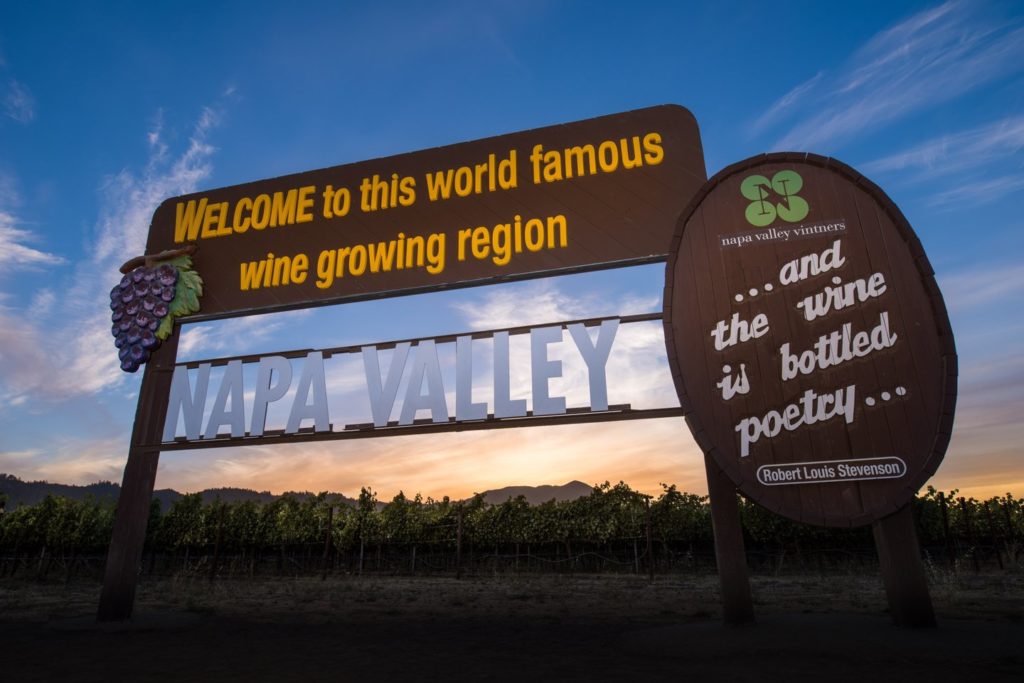
The world-famous wine growing region of Napa Valley was first named an American Viticultural Appellation in 1981. Photo courtesy of Visit Napa Valley. Photo Credit: Visit Napa Valley.
ATLAS PEAK
Napa Valley Appellation
Elevation: 760 – 2,600 feet
Key Varieties: Cabernet Sauvignon, Chardonnay
Known for its higher elevation, the Atlas Peak AVA is above the fog line that conditions most of the Napa Valley thanks to lower lying bodies of water such as the San Pablo Bay and the Pacific Ocean. Its mountain-influenced climate keeps extreme temperatures at bay.
While the origin of the name Atlas Peak for the mountain and region is unknown, the earliest print reference to the name Atlas Peak appeared in an 1875 issue of the Napa County Recorder. The region initially gained renown as a place with a “healthful climate” that “offered relief to sufferers of asthma and other respiratory ailments.”
Calistoga
Napa Valley Appellation
Elevation: 300 – 1,200 feet
Key Varieties: Cabernet Sauvignon, Zinfandel, Syrah, Petite Sirah
The Calistoga AVA is the northernmost of the “valley floor” appellations in Napa Valley, and the hottest. It is surrounded by mountains on three sides, except where it borders St. Helena in the south, and is known for significant temperature dips from daytime to night.
Look out for opportunities to discover the distinct wines of Calistoga through the town of Calistoga’s Winter in the Wineries Passport program–an annual event offering special tastings and exclusive discounts at regional wineries and tasting rooms.
While Calistoga was recognized as a distinct wine growing area in the 1881 book, History of Napa and Lake Counties, it was officially recognized as an American Viticultural Area thanks to Bo Barrett of Chateau Montelena fame, who first filed the appellation petition in 2003.
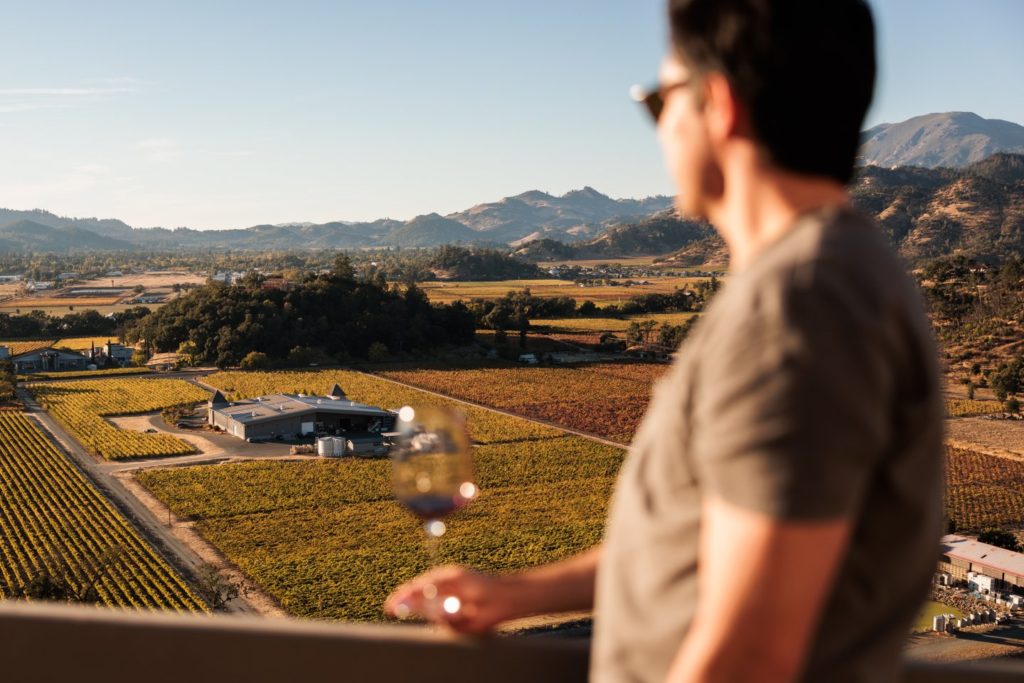
A bird’s eye view of Calistoga from Sterling Vineyards. Photo Credit: Max Whittaker for Visit CA, Visit Napa Valley.
CHILES VALLEY
Napa Valley Appellation
Elevation: 600 – 1,200 feet
Key Varieties: Cabernet Sauvignon, Merlot, Cabernet Franc, Zinfandel
A long, skinny, and high-elevation valley, the Chiles Valley AVA boasts more vineyards than wineries and enjoys primarily volcanic soils. Chiles Valley is completely ringed by mountains, so while the elevation plays a cooling role, its architecture can act like an oven, trapping hot air. Chiles Valley wines tend to be full-flavored, with a notable elegance, due to the prolonged growing season created by the elevation. Its notable varieties include Cabernet Sauvignon, Cabernet Franc, and Zinfandel.
In the 1890s–when Phylloxera arrived, killing over 80% of vineyards in Napa Valley–the grapevines of Chiles Valley were relatively untouched due to the area’s isolation. There are still pre-Phylloxera Zinfandel grapevines alive to this day, producing low-yielding grape harvests and Zinfandels with rich, concentrated flavor.
COOMBSVILLE
Napa Valley Appellation
Elevation: Sea level – 700 feet
Key Varieties: Pinot Noir, Merlot, Chardonnay, Cabernet Sauvignon
With a wide range of elevations, the Coombsville AVA is known for its cooler, marine influenced climate, as it sits directly east of the City of Napa. The vast majority of its vineyards spread across a west-facing concave bowl, formed through millennia of landslides. Its proximity to the San Pablo Bay keeps the area awash in fog and sea breezes. Historically, the region was associated with Pinot Noir and Chardonnay plantings, but many admire the backbone of the region’s Cabernet Sauvignons.
Coombsville is named after Nathan Coombs, one of the early settlers of Napa Valley. Initially focused on livestock and subsistence farming, it was only in the mid-20th century that the region began to attract attention from grape growers and vintners.
Crystal Springs of Napa Valley
Napa Valley Appellation
This approximately 4,000-acre appellation is the newest in Napa Valley. The Crystal Springs of Napa Valley AVA is “all-hillsides,” and highlights vineyards tucked into the western face of Napa Valley’s Vaca mountain range. Established in late 2024, Crystal Springs is home to 230 acres currently planted to vineyards, growing varieties including Cabernet Sauvignon, Merlot, Cabernet Franc, Malbec, and Sauvignon Blanc.
Expect a bright future from this new Napa Valley nook!
Diamond Mountain District
Napa Valley Appellation
Elevation: 400 – 2,200 feet
Key Varieties: Cabernet Sauvignon, Cabernet Franc
Inspired by the reflective shards of volcanic glass material and obsidian found throughout its soil, Napa Valley’s Diamond Mountain District AVA rises into the east side of the Mayacamas mountains, southeast of Calistoga. Cabernet Sauvignon is the region’s dominant and prolific grape. Much of the terrain of Diamond Mountain is too severe to be cultivated, and a significant section of its mountainsides remain covered in thick Redwoods.
Following Prohibition, wine production returned to Diamond Mountain thanks to Jack and Jamie Davies, who purchased the region’s historic Schramsberg property in 1965. Other winemakers returned through the 1960s and 1970s, with Rudy Von Strasser and Andre Tchelistcheff developing famous vineyards in the area.
HOWELL MOUNTAIN
Napa Valley Appellation
Elevation: 600 – 2,600 feet
Key Varieties: Cabernet Sauvignon, Merlot, Zinfandel
The first mountainous nested appellation of Napa Valley, the Howell Mountain AVA begins at 1400 feet above sea level. Overlooking the town of St. Helena, Howell Mountain’s position entirely above the fog line–combined with its plateau shape–means that many of its vineyards are open to unmitigated sunshine. This tends to produce wines that range from dark and decadent to fragrant and tannic, depending on the producer.
In 1877, two of the area’s first winemakers, Jean Adolph Brun and Jean V. Chaix, planted 20 acres of grapevines from seven varieties which were sourced from Medoc in Bordeaux. Additional early Howell Mountain winemakers included Charles Krug, J. Thomas and George McMee.

Discover the range of limited production, winery-exclusive Etude wines in the relaxed atmosphere of its light-filled Carneros tasting room. Photo Credit: Etude Wines.
LOS CARNEROS
Napa Valley Appellation
Elevation: Sea level – 700 feet
Key Varieties: Pinot Noir, Merlot, Chardonnay
Known for its significantly cooler climate–due to its proximity to fog and cooling breezes of the San Pablo Bay– the Los Carneros AVA spans across both Napa Valley and Sonoma counties. Because of this, it is typically not considered “nested” within the Napa Valley, though the Napa part of the region is referred to as “Los Carneros.”
Los Carneros is widely considered to be “Napa’s Burgundy,” as Pinot Noir and Chardonnay thrive here. That said, it is also the source of Napa Valley’s sparkling wines. Multiple sparkling houses have set up shop here and produce world-class bubbly.
The area now known as Los Carneros AVA is comprised of at least three original Mexican land grants: Rincon de los Carneros, Entre Napa and Huichica Ranchos, which were later awarded by General Mariano Vallejo to friends and family. The name Los Carneros translates to “The Rams” in Spanish.
MOUNT VEEDER
Napa Valley Appellation
Elevation: 500 – 2,600 feet
Key Varieties: Cabernet Sauvignon, Merlot, Zinfandel, Chardonnay
One of the coolest of the mountain appellations in Napa Valley, with remarkably rugged topography, the Mt. Veeder AVA is known for low grape yields and high “ageability” of its wines, including Cabernet Sauvignon and Merlot. Located on the eastern slopes of the Mayacamas Range that separate Napa Valley and Sonoma Valley, it is one of Napa Valley’s largest AVAs–yet is one of the least planted, due in large part to the extreme cragginess of the terrain.
The first winery in the area was built by John Hein, and six other wineries were known to exist in the area by the mid 1880s. The Mount Veeder AVA is named after the Reverend Peter V. Veeder, a Presbyterian pastor.
Oak Knoll District
Napa Valley Appellation
Elevation: Sea level – 500 feet
Key Varieties: Cabernet Sauvignon, Merlot, Chardonnay, Sauvignon Blanc
The Oak Knoll District AVA is one of Napa Valley’s flatter appellations at the southern end of Napa Valley’s floor. Its regular fog keeps temperatures down, which means the wines tend to be among the more elegant and understated. In addition to varieties including Cabernet Sauvignon, you can find small amounts of Riesling grown in this pocket of Napa Valley.
Since the end of Prohibition, numerous vineyards have been planted in the Oak Knoll District, now totaling over 4,150 acres of planted grapevines.
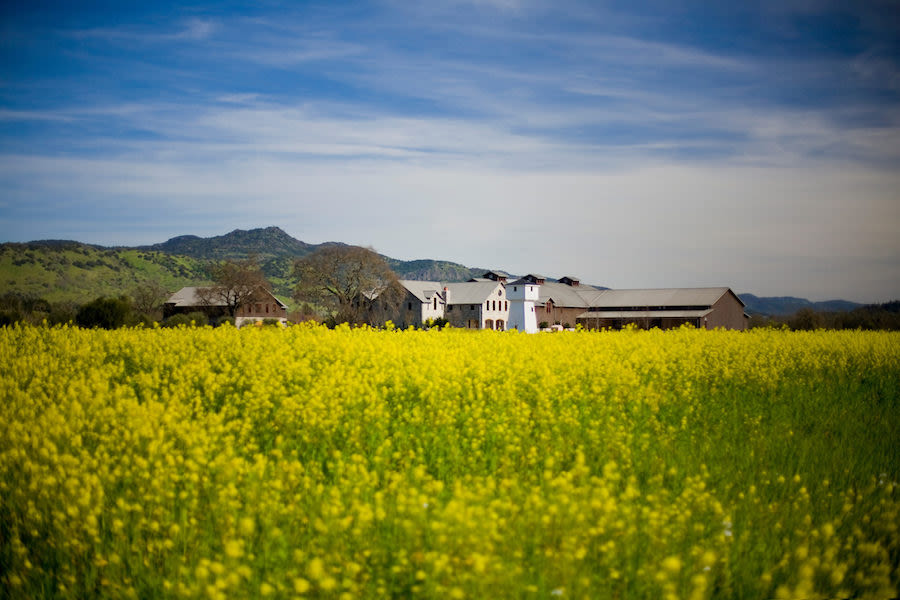
Step into the birthplace of Silver Oak in Oakville, where you’ll be welcomed with an experience that celebrates craftsmanship and world-famous Napa Valley cabernet sauvignon. Photo Credit: Silver Oak.
OAKVILLE
Napa Valley Appellation
Elevation: Sea level – 500 feet
Key Varieties: Cabernet Sauvignon, Merlot, Sauvignon Blanc
The Oakville AVA is one of Napa Valley’s most prestigious subregions. The site is home to many famous and historic vineyards and wineries. Located in the heart of Napa Valley, Oakville experiences both the heat of Napa Valley’s northern reaches and the cooling influence of San Pablo Bay’s fog and breezes. Because of this, the Cabernet-centric region’s wines, while ripe and powerful, tend to exhibit remarkable finesse and energy.
Today the Oakville AVA has over 5,000 acres of land planted to grapevines, with over 50 wineries sourcing their grapes from this appellation. The University of California, Davis currently maintains a 40-acre research vineyard and laboratory facility called Oakville Station.
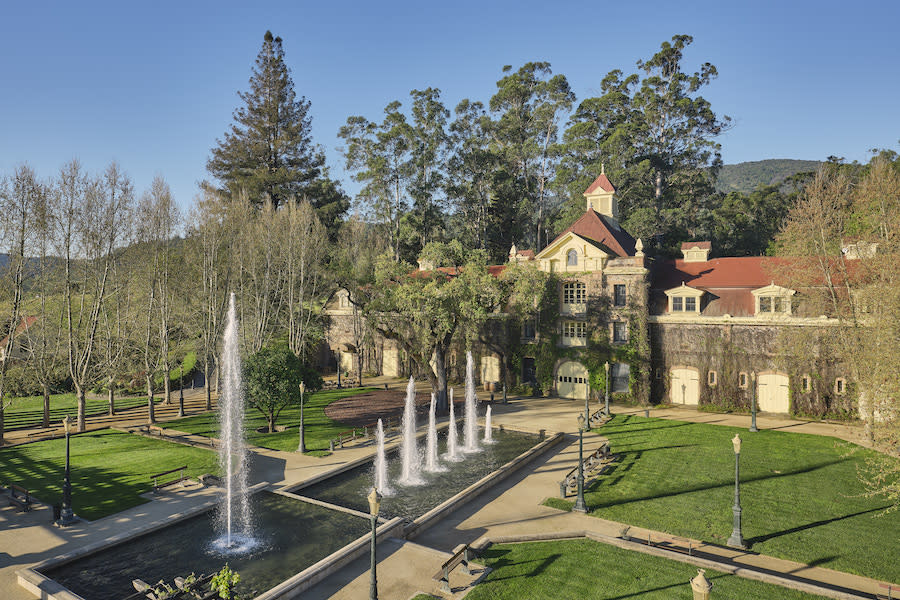
The Inglenook legacy began in 1879, when Gustav Niebaum, a Finnish sea captain, wine connoisseur, and entrepreneur, came to Rutherford to build a wine estate that would rival Europe’s finest. Photo Credit: Inglenook.
Rutherford
Napa Valley Appellation
Elevation: Sea level – 600 feet
Key Varieties: Cabernet Sauvignon, Merlot, Cabernet Franc, Zinfandel
Known for its warm abundant sunshine, cool evenings, and famously grainy soils, the Rutherford AVA is well-suited to wine production, and its numerous historic and famous vineyards were responsible for some of the first perfect-scoring, 100-point rated wines in Napa Valley. Cabernet Sauvignon is its dominant grape, but Sauvignon Blanc is also plentiful and makes for an especially charming and tropical wine when grown here.
In addition to solidifying Rutherford’s status as a fine wine producing region, prominent pioneering winemaker Georges de Latour inspired future Napa Valley generations to fall in love with the region, including Andre Tchelistcheff.

At Raymond Vineyards in St. Helena, guests enjoy immersive, educational and sensory journeys that highlight the elegance and innovation of Napa Valley wines. Photo Credit: Raymond Vineyards.
St. Helena
Napa Valley Appellation
Elevation: 100 – 700 feet
Key Varieties: Cabernet Sauvignon, Cabernet Franc, Merlot, Syrah, Zinfandel
Located in the narrower northern valley floor and known for consistently warm weather, the St. Helena AVA is named after the Napa Valley town and mountain of the same name. This subregion has an unusual shape, like an hourglass. The northern half is similar in feel and temperature to Calistoga, while the southern half is likened to Rutherford. Cool, mountain-influenced Cabernet Sauvignon and Chardonnay grow well here.
Originally named “Kanamota” or “Human Mountain” by the indigenous Wappo people of Napa Valley, Mount St. Helena was initially renamed as “Mount Mayacamas” by Spanish colonists before receiving its modern name in 1841.
Spring Mountain District
Napa Valley Appellation
Elevation: 600 – 2,600 feet
Key Varieties: Cabernet Sauvignon, Merlot, Chardonnay, Sauvignon Blanc
Known for its exposure to the coastal influence of the Pacific Ocean, the Spring Mountain District AVA is the wettest of all the Napa Valley appellations. Thanks to the mountain’s craggy facade, area vineyards tend to be small, spread out, and surrounded by forest.
While the steep, well drained soils of the area provide grapevines with sufficient moisture, they also cause stress on the vines during the late summer and early fall, which limits grape yields and produces smaller grapes with higher flavor concentration. Wine enthusiasts often seek out Cabernet Sauvignon, Merlot, and Chardonnay from the region.
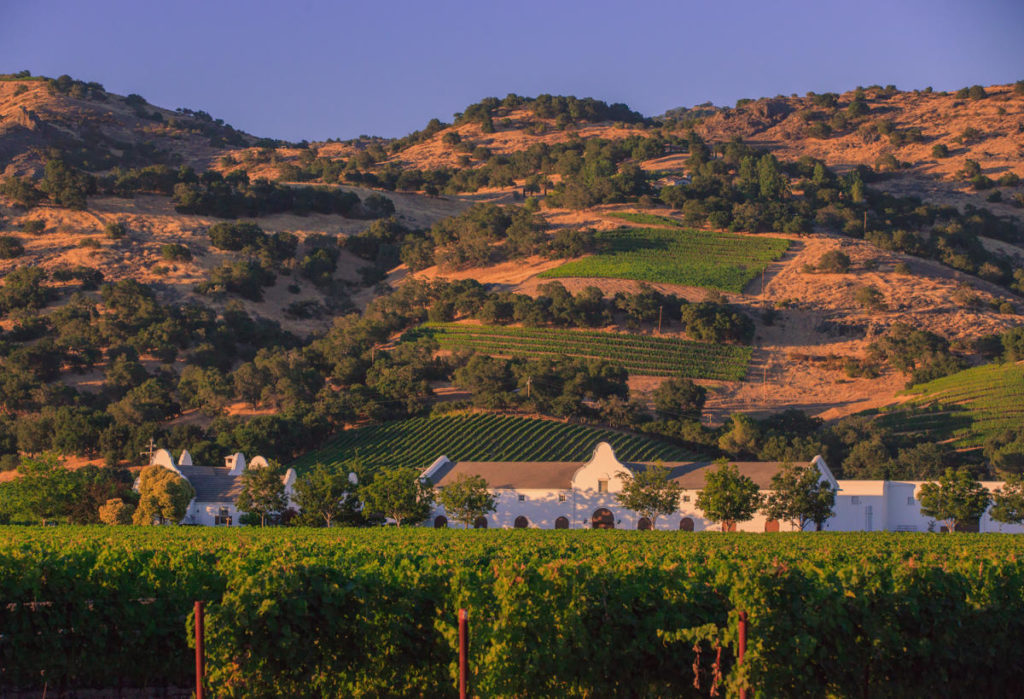
All the grapes for Chimney Rock‘s Cabernet Sauvignon and Bordeaux style red blends are grown on the winery’s 131-acre estate at the southern end of the Stags Leap District. Photo Credit: Chimney Rock Winery.
Stags Leap District
Napa Valley Appellation
Elevation: Sea level – 500 feet
Key Varieties: Cabernet Sauvignon, Merlot, Chardonnay, Sauvignon Blanc
The Stags Leap District AVA is known for being the first American Viticultural Area in the United States created based on the distinct qualities of its soil. The region’s soils are a mix of sandstone, shale, gravelly loam and volcanic material–ideal for Napa Valley Cabernet Sauvignon.
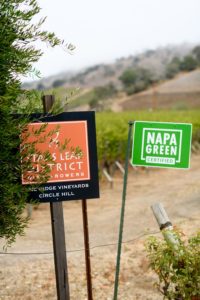
Stags Leap District rose to fame following the famous Judgement of Paris Tasting in 1976. Photo Credit: Pine Ridge Vineyards and Jimmy Hayes.
Most famously, the region produced the award-winning Cabernet Sauvignon that put Napa Valley on the map and won the Judgment of Paris wine competition in 1976. Stags Leap Cabernets are known for being an “iron fist in a velvet glove.” This is due to the region’s soils, wind- and fog-swept environment, and considerably long growing season.
The origin of the name “Stags Leap” has several theories, but the most popular one is attributed to a native Wappo legend of a wild stag who evaded an entire generation of hunters by leaping and vanishing at the last moment.
Wild Horse Valley
Napa Valley Appellation
Elevation: 600 – 1,900 feet
Key Varieties: Cabernet Sauvignon, Pinot Noir, Chardonnay
One of the smallest Napa Valley appellations, the Wild Horse Valley AVA is known for its relatively cooler climate due to its proximity to the San Pablo Bay– beneficial for the cultivation of grape varieties like Pinot Noir.
Wild Horse Valley wines are under-the-radar because so little of them are made. Chardonnay and Pinot Noir tend to be planted over Cabernet Sauvignon in this cool-climate area, with its wines typically featuring slightly higher acidity due to the elevation.
Due to its relative isolation, Wild Horse Valley doesn’t have the long history of other Napa Valley AVAs. Nearly 60 years after Prohibition, the first new grape vines were planted on 1100 acres by John Newmeyer in 1978.
Yountville
Napa Valley Appellation
Elevation: 20 – 200 feet
Key Varieties: Cabernet Sauvignon, Merlot
Named after American pioneer, trapper and frontiersman George Yount, the Yountville AVA offers some of Napa Valley’s most elegant, refined and intricate wines, from Cabernet through to Sauvignon Blanc, thanks to its low-elevation terrain without mountain influence. The region sits near the Napa Valley town of Yountville, known for some of the region’s finest hotels and Michelin-rated restaurants.
George Yount’s original rancho would eventually grow to become some of the most valuable vineyard real estate in America. In 1864, George Yount gave a 1040-acre portion of the Caymus Rancho to his granddaughter Elizabeth and her new husband Thomas Rutherford as a wedding gift. That Napa Valley area, now called Rutherford, still bears their name to this day.
Taste Through Napa Valley Wines – Plan Your Trip
Across its 35 miles, the diverse subregions within Napa Valley uniquely contribute to the story of Napa Valley and its influence on the wine world today. Each subregion of Napa Valley showcases distinctive microclimates and soils that shape its terroir, leading to incomparable blends and world-class wines.
Whether it’s the volcanic soils of Atlas Peak or the cool, foggy climate of Los Carneros, every subregion contributes to the rich tapestry of Napa Valley’s winemaking heritage.
There’s a better way to familiarize yourself with Napa Valley’s wine history: Immersive education. If you are interested in visiting Napa Valley’s iconic vineyards, plan a trip to Napa Valley to discover its 400+ wineries and unique wines!